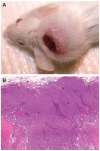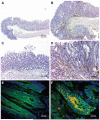Gastric cancer stem cells
- PMID: 18539967
- PMCID: PMC2743304
- DOI: 10.1200/JCO.2007.15.2603
Gastric cancer stem cells
Abstract
Cancer stem cells are defined as the unique subpopulation in the tumors that possess the ability to initiate tumor growth and sustain self-renewal as well as metastatic potential. Accumulating evidence in recent years strongly indicate the existence of cancer stem cells in solid tumors of a wide variety of organs. In this review, we will discuss the possible existence of a gastric cancer stem cell. Our recent data suggest that a subpopulation with a defined marker shows spheroid colony formation in serum-free media in vitro, as well as tumorigenic ability in immunodeficient mice in vivo. We will also discuss the possible origins of the gastric cancer stem cell from an organ-specific stem cell versus a recently recognized new candidate bone marrow-derived cell (BMDC). We have previously shown that BMDC contributed to malignant epithelial cells in the mouse model of Helicobacter-associated gastric cancer. On the basis of these findings from animal model, we propose that a similar phenomenon may also occur in human cancer biology, particularly in the cancer origin of other inflammation-associated cancers. The expanding research field of cancer stem-cell biology may offer a novel clinical apparatus to the diagnosis and treatment of cancer.
Figures



References
-
- Houghton J, Morozov A, Smirnova I, et al. Stem cells and cancer. Semin Cancer Biol. 2007;17:191–203. - PubMed
-
- Lapidot T, Sirard C, Vormoor J, et al. A cell initiating human acute myeloid leukaemia after transplantation into SCID mice. Nature. 1994;367:645–648. - PubMed
-
- Bonnet D, Dick JE. Human acute myeloid leukemia is organized as a hierarchy that originates from a primitive hematopoietic cell. Nat Med. 1997;3:730–737. - PubMed
-
- Lobo NA, Shimono Y, Qian D, et al. The biology of cancer stem cells. Annu Rev Cell Dev Biol. 2007;23:675–699. - PubMed
Publication types
MeSH terms
Grants and funding
LinkOut - more resources
Full Text Sources
Other Literature Sources
Medical

